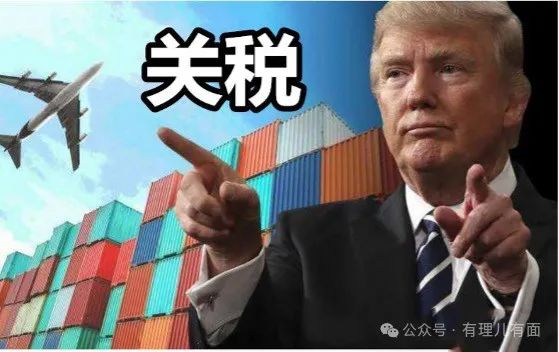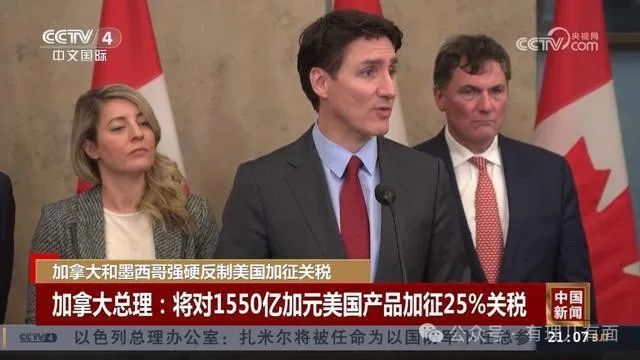On March 4, the Donald Trump administration imposed a 25 percent tariff on Canadian and Mexican imports.

U. S. tariffs on allies Canada and Mexico were laid a month ago. On February 1, Donald Trump signed an executive order imposing a 25 per cent tariff on Canadian and Mexican goods for their”Failure to stop the flow of drugs and illegal immigrants into the United States”.

The situation lasted only 48 hours, however, before a phone call from Donald Trump turned the tables. The Mexicans agreed to immediately send 10,000 National Guard of the United States agents to the us-mexico border specifically to combat fentanyl’s smuggling and illegal immigration, and pledged to co-operate with the US in monitoring the border; Canada announced $1.3 bn to strengthen border management, including helicopters, surveillance technology and nearly 10,000 law enforcement personnel, as well as designating drug cartels as terrorists and forming a joint strike force with the US.
In exchange, on February 3 Donald Trump”Generously” postponed the date of the tariffs’ entry into force by 30 days to March 4, and praised both countries for”Showing good faith”. This”Maximum pressure — compromise — pause” approach is what analysts call the”Window-opening effect”– Donald Trump threatens to”Tear down the house” and then demands a”Window”, force the other party to accept a relatively small price.
“It’s like trying to fight a fire with a stick,” says a Canadian academic. “Taking a step back will only make Donald Trump greedier.”. Donald Trump’s tariff stick hung over Canada and Mexico during the 30-day reprieve. On February 24th Donald Trump, in a meeting with Maqueron, the French president, boasted that”Tariffs will go ahead as scheduled” and accused trading partners of”Taking advantage of the US”. Meanwhile, United States Department of Commerce Lutnick sent mixed signals, saying”The president could announce tariff reductions soon”. This”A good cop, a bad cop” strategy, so that Canada and Mexico are struggling to cope.
Mexico has stepped up its deployment of troops at the border, even allowing U. S. military aircraft to enter the country to repatriate migrants. The Trudo administration was accused of being”Soft on the ” when the March 9 election for the Liberal leadership was overshadowed by the tariff threat. Donald Trump’s appetite, however, is far from sated. On February 26th he suddenly announced a”25% across-the-board tax increase on Mexican goods and a 25% tax increase on Canadian non-energy goods as of April 2nd” and threatened action against the European Union. The flurry of activity sent markets into a tailspin, sending stocks tumbling for a second day and European stocks down the most in six months.
On March 3, Donald Trump confirmed that the Canadian and Mexican tariffs would take effect on March 4. On March 4, the boots finally landed. In response, Canadian Prime Minister Trudo announced a two-stage retaliation: the first would immediately impose a 25 percent tariff on $30 billion worth of American steel, agricultural products and consumer goods; The second phase will raise tariffs on c $125bn of US goods in 21 days, covering cars, machinery and chemicals and accounting for a third of Canada’s total imports from the US. Trudo said bluntly that this was a necessary response to”Very stupid tariffs” and hinted at the possibility of”Non-tariff measures”, for example, limiting electricity exports to the U.S. — Canada sends 8% of its electricity to the U.S. each year — could send prices skyrocketing in places like New York State.
More News, Canada is with the European Union, Japan to form an”Anti-customs union”, plans to jointly implement reciprocal retaliation. Not to be outdone, too, is Mexico. At a morning news conference on March 4, Mexican President Joachim Sinbaum said his country does not accept hegemony of any kind, and faced with American tariffs that violate the two countries’ free trade agreement, the Mexican government will respond firmly and formally announce specific tariff and non-tariff countermeasures at 12 noon on March 9. Sinbaum also stressed that the United States will not be responsible for the drug problem, Mexico and the United States in the security and drug cooperation must be based on respect and reciprocity. Once again, however, the drama has played out.
On March 4, United States Department of Commerce Lutnick abruptly reversed himself, saying that”Donald Trump may reduce tariffs on Canada and Mexico, with an agreement to be announced as early as March 5[ local time ]”. With less than 24 hours to go before the tariffs take effect and markets still reeling from the shock, Donald Trump’s U-turn has left his allies in stitches. Donald Trump’s tariffs were a carefully choreographed charade, with tariffs raised on February 1, suspended on February 3, threatened to go ahead on February 24, implemented on March 4, and considered for cuts on March 5. … The essence of this cycle of”Carrot and stick” is to weaponize tariffs and force concessions by creating uncertainty As the Wall Street Journal put it, “Donald Trump’s tariffs are not an economic tool, but a political scare tactic.” “Every time we step back, Donald Trump steps forward,” the Mexican scholar said, “He talks about tax cuts today and may find new reasons to increase them tomorrow.”, an across-the-board tax increase would have an economic impact comparable to covid-19 The costs to the U.S. are just as high: the Great Lakes auto industry is facing a $3,000 increase in the price of new cars because of its dependence on Canadian parts, and Texas refineries are at risk of losing electricity to Mexico. In contrast to the wavering compromises in Canada and Mexico, China’s response to the doubling of us tariffs on Chinese goods from 10 per cent to 20 per cent has been crisp and swift . On 4 February, china announced export controls on strategic resources such as tungsten and tellurium, and imposed a 15% tariff on US liquefied natural gas and a 10% levy on crude oil and large-displacement vehicles, hitting the interests of oil and gas capital behind Donald Trump, the precision of the strikes has left American companies 2024 — Chinese imports liquefied natural gas 4.15 million tons, or 21 percent of total U.S. exports On March 4, China further escalated its reciprocal countermeasures by issuing several countermeasures in succession, with the spokesperson of the Ministry of Foreign Affairs emphatically stating that the Chinese people never believe in evil, are not afraid of ghosts, and will never accept the tricks of bullying Looking back at Donald Trump’s tariffs, it is more significant that his actions are accelerating the restructuring of global supply chains A German think-tank predicts that China could overtake the US as the EU’s largest trading partner in the event of a us-eu tariff war, while south-east Asian countries would seize the low-end production capacity being displaced from China. As Stiglitz, the Nobel economist, puts it, “The US is destroying the trading system of its own making, with China as the stabiliser in the mess.”
Donald Trump’s tariff farce exposed the end of the era of unipolar American hegemony. Canada and Mexico at first compromise, but the United States changed its orders, playing with allies, quickly changed face and imposed tariffs, so that it moved towards resistance. Together, China’s shift from defensive to aggressive tactics points to the reality that the era of the U. S. brandishing a big stick is over. And global markets, spooked by Wolf attacks, are losing patience with U.S. credit — after all, who wants to bet against a fickle player for long?
Image from the web